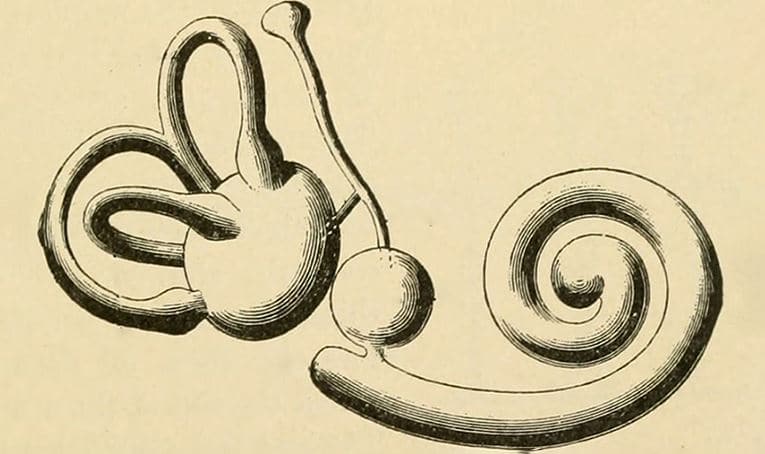The ceaseless march of technological progress in hearing science continues to amaze, yet mysteries of the ear still abound. Two recent headlines in the news show that as some questions get answered, others remain open.
A study published June 19 in eLife, revealed a unique biological mechanism for maintaining fluid pressure and composition involving the endolymphatic sac, a fluid-filled vessel connected to the rest of the inner ear by a long, thin duct. Results of the study may aid in the treatment of disorders involving the inner ear, such as Meniere’s disease, a relatively common condition marked by vertigo, hearing loss and ringing in the ears.

The endolymphatic sac (top center) its connected to the rest of the inner ear via a long thin duct. Image: Internet Archive Book Images, via HMS
Harvard Medical School researchers, Ian Swinbourne and Sean Megason, determined that the endolymphatic sac acts as a pressure-relief valve and is formed by a thin barrier of cellular projections that opens and closes to regulate the release of fluid from inside the inner ear. They made their initial observation of this phenomenon while conducting a time-lapse microscopy study of the inner ear of zebrafish. They noticed a tiny structure in the inner ear was pulsating like clockwork, inflating and deflating over and over.
Over the course of the next several years, Swinburne and Megason worked to better understand the function of this mysterious structure. To do so, they had to visualize it in action. Collaborating with some of the world’s leading microscopy laboratories, they pieced together different views of the endolymphatic sac until a clear picture emerged.
In addition to improving the treatment of inner ear conditions, their results might help researchers study pressure control in other organs such as the eyes and kidneys, which also have liquid-filled cavities.
These insights on the functions of the inner ear in some ways pale in comparison to the ongoing mystery in the series of alleged sonic attacks, first occurring in Cuba some 18 months ago, and now possibly happening in China. In early June it was reported by the Wall Street Journal that Americans were being evacuated from diplomatic sites due to a mysterious condition, with symptoms like the series of on-going acoustic attacks in Cuba, beginning in 2016.
On July 1, the Wall Street Journal reported that at least nine Americans have been medically evacuated from China following complaints in recent months of abnormal aural sensations. The story also reported more than 250 American have received treatment for the aural attacks. The attacks were centered around the city of Guangzhou, which is the location of an American consulate office.
Sources: Harvard Medical School; WSJ; image courtesy wikimediacommons







It is possible that ultra low frequency sound waves can cause dizzy sensations. But how does one produce such wave forms so as to directionaly affect, only Americans, in a hotel ? This research is bogus, false and a blind attempt to place the problem on an unknown quantity. Its a wild guess at best.The military has used such technology in the past. Tibetans used ULF transmission on its enemy with the use of long trumpet like devices. It could be possible that such ULF transmissions could be beamed down from satellites to specific geographical locations but that techniques is already known to us. It may be classified at this time.